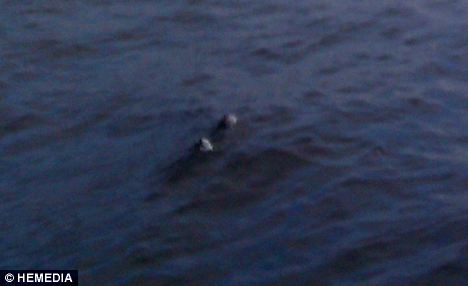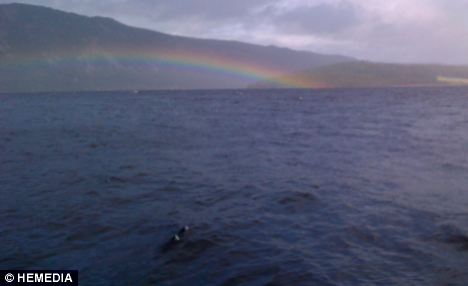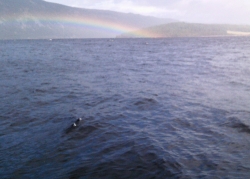
September 15, 2011
It has been a relatively active year at Loch Ness. As you may recall, a new photograph surfaced in July (see here) and now comes another one.

Jon Rowe, 31, a fish farmer, from Lewiston in Drumnadrochit, Scotland, took the newest photographs of what might be one of the Loch Ness Monsters or Nessies moments before the mysterious shape slipped beneath the water. He said he got the photograph on September 7, 2011, Wednesday at 8:30 am.

It was a very strange morning. It was misty with a bit of rain and sunny at the same time. There was a rainbow so I got my camera out to take a photo and noticed this really large dark shape in the loch with two humps that were barely out of the water. My instant reaction was “That’s Nessie.”
…
It wasn’t up for a long long time. It was a really large dark shape and I’ve not seen anything like that on Loch Ness before. I think it’s interesting, that’s how I take it and I would like the photo to be checked.
…
I have no doubt, I work on the loch everyday and I’ve never seen anything like it. Almost as soon as I took the shot the shape disappeared under the water and out of sight. It can’t have been a buoy or a mooring as it’s in the wrong place and the ropes would be visible in the water. A few people have said it was birds diving under the water – but I didn’t see any birds fly by. It can’t have been birds – the whole thing went down into the loch. It was quite spooky but I think it’s really interesting.
Jon Rowe
Adrian Shine of the Loch Ness Project based in the Loch Ness Center in Drumnadrochit thought one possible explanation for the photo could be that it was two black throated diver birds captured diving for prey or emerging after a dive. Indeed, I have to agree with Shine that the image published appears to be of two water birds, perhaps loons.

In Scotland, the “black throated diver bird” is the name given to what we call the loon in North America. The black-throated loon (Gavia arctica) is a migratory aquatic bird found in the northern hemisphere. The species is also known as an Arctic Loon in North America and the Black-throated Diver in Eurasia. They often swim in twos, as mated pairs. I have observed them often in various locations through North America, especially in Maine.

John Audubon saw and painted loons, also called “northern divers” or “black-throated divers” in 1833 on his expedition to Labrador. It is uncertain if the above is from that trek, but it is an Audubon painting of loons, as is the following.


For more, see here, here, and here.
About Loren Coleman
Loren Coleman is one of the world’s leading cryptozoologists, some say “the” leading living cryptozoologist. Certainly, he is acknowledged as the current living American researcher and writer who has most popularized cryptozoology in the late 20th and early 21st centuries.
Starting his fieldwork and investigations in 1960, after traveling and trekking extensively in pursuit of cryptozoological mysteries, Coleman began writing to share his experiences in 1969. An honorary member of Ivan T. Sanderson’s Society for the Investigation of the Unexplained in the 1970s, Coleman has been bestowed with similar honorary memberships of the North Idaho College Cryptozoology Club in 1983, and in subsequent years, that of the British Columbia Scientific Cryptozoology Club, CryptoSafari International, and other international organizations. He was also a Life Member and Benefactor of the International Society of Cryptozoology (now-defunct).
Loren Coleman’s daily blog, as a member of the Cryptomundo Team, served as an ongoing avenue of communication for the ever-growing body of cryptozoo news from 2005 through 2013. He returned as an infrequent contributor beginning Halloween week of 2015.
Coleman is the founder in 2003, and current director of the International Cryptozoology Museum in Portland, Maine.
Filed under Breaking News, CryptoZoo News, Cryptozoology, Eyewitness Accounts, Lake Monsters, Loch Ness Monster